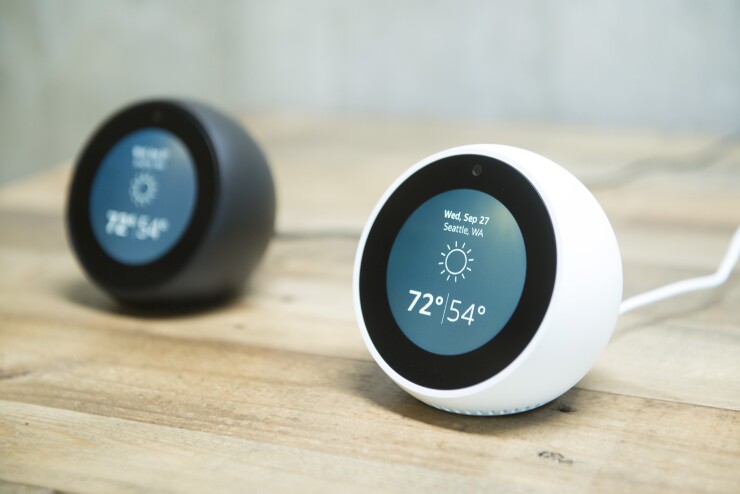When Ally Bank was testing the usability of its service for Amazon’s digital voice assistant, the direct bank saw a risk for Alexa to interpret “high yield” as “high heeled.” Ally fine-tuned the code on devices like Echo to properly
After a number of months of testing and refining an alternative way to bank, Ally Bank launched
As natural language processing devices become ubiquitous, some banks have taken a lead in testing and developing the technology, demonstrating to wealth managers and other financial service providers how it can reshape client communications. These early movers view launching service capabilities on Alexa — known as skills — as a way to engage someone with an even easier way to bank: Instead of pulling out a phone and launching an app, a customer can simply say what he wants to do, just like commanding a genie from a lamp.
In recent months, what has been a curiosity in banking is gaining momentum in time for the holidays. Since

Most banks, however, have yet to even dabble with the nascent technology.
“The reason why people are slow to move into this space is it is quite hard to find what the use cases are,” said Chris Ward, a principal consultant at Mapa Research, a digital banking consultancy.
For now, some analysts believe pulling a mobile banking app up to, say, see a balance is easier than talking to Alexa, which may require a code to use a bank skill. "The interaction is [still] too clunky and it takes too long for the value I’m getting as a consumer,” said Emmett Higdon, director of digital banking at Javelin Strategy & Research. However, Higdon sees a day when voice-driven banking could reduce the clutter of the multiscreens required of someone to, say, make a payment from a bank account to another — because the technology will authenticate the person by this voice. “Home is absolutely becoming a new channel for us,” Higdon said.
Millions sold
According
Whether Alexa banking becomes a staple still remains to be seen, but banks with skills are keen to follow and find out, and regardless, it exposes them to the bigger picture of connected devices.
Since September, U.S. Bank has let customers check their balances and make payments to U.S. Bank credit cards, among other things, speaking to Alexa. So far, the bank has deemed the launch as successful. “Customers who are using it seem to really like it,” said Gareth Gaston, head of omnichannel banking at U.S. Bank. While the bank isn’t disclosing usage numbers, he said people who ask Alexa a question tend to ask a follow-up question.
Move over AI. Here are six emerging tools that could become the new norm next year.
Already, Gaston said, U.S. Bank plans to launch on Siri and Google Home and he can see a day where the lines will blur between talking to Alexa or a call center — especially when voice-based authentication on the devices exist. “I think this is the very, very tip of the iceberg that we are seeing,” he said.
Not only can he easily envision a day where someone speaks his Zelle request, but also a day where one could apply for a mortgage. “It just takes time,” he said. As he sees it, finding and tapping into a mobile app while at home is more of a hassle than asking Alexa for something. In other words, voice banking removes the friction that is still a part of mobile banking.
An interaction puzzle
To be sure, where the client is and who is with him will influence how a person banks. Adopting this technology, banks may be closer to achieving the ideal behind the premise that first tagged online banking as “home banking.”
Banking is, after all, private and personal. For voice banking, perhaps there is dead time while driving or when someone is cooking spaghetti carbonara and wants to pay a credit card but there is sauce on his hands. On the other hand, customers may not want to bellow out about paying bills in a waiting room or sitting on a plane.
Already, there have been lessons in the degree of the many ways someone could ask Alexa the same question. A customer could say, “Transfer money” or “I want to move money” or “Pay a bill” — all things Alexa needs to know. Ally Bank, for instance, spent time testing and thinking about the many ways a customer might ask for something in an attempt to avoid Ally not knowing how to handle a request. “We don’t want new innovations to create frustrations for customers,” Morais said.

How people are asking questions — which varies by region and dialect and age — and what their true intent is among the learnings that FIS is continuing to try to puzzle together, according to Doug Brown, head of mobile at FIS.
For instance, a customer might ask Alexa about "The Odyssey" and the assistant would need to figure out if the person meant the Honda minivan or the classic tale. True, Alexa will know the request is tied to money for a bank skill; however, interpreting intent is among the challenges Brown deems interesting to solve by trial and error. “You ingest data and learn from the interaction,” he said.
While Ally Bank already allows money movement (clients are asked to set up a six-digit passcode code to do so) FIS said it is waiting a little longer to make money movement functionality available. At launch, the FIS bank skill will connect to lower-risk transactions, like checking account balances and daily financial briefings. FIS is waiting to launch bill pay as part of voice-command banking until some adjustments are made on Amazon’s end to help ensure the right person is making the request for the riskier transaction.
In time, Brown sees voice-command technology as helping the consumer accomplish a task on his time — he could start a task in the morning, and wrap up the request on the car ride to work, if not schedule an appointment with a human, should he require it.
“We are very bullish,” said Brown, adding that not every task gets accomplished within 30 seconds on a mobile app or countertop.
But like most technologies, don’t expect voice banking to replace older channels, including smartphone banking. “We think it’s an ‘and’ opportunity,” Brown said.






